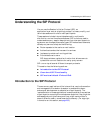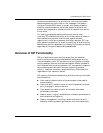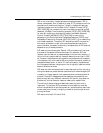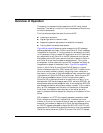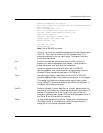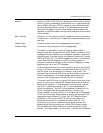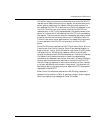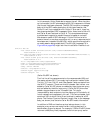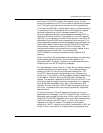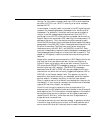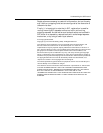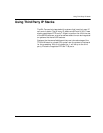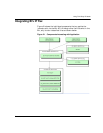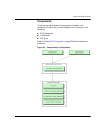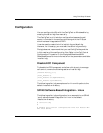
Understanding the SIP Protocol
November 2009 252
In this example, Caller B decides to answer the call. When he picks
up the handset, the SIP phone sends a 200 (OK) response to indicate
that the call has been answered. The 200 (OK) contains a message
body with the SDP media description of the type of session that
Caller B is willing to establish with Caller A. As a result, there is a
two-phase exchange of SDP messages: Caller A sent one to Caller B,
and Caller B sent one back to Caller A. This two-phase exchange
provides basic negotiation capabilities and is based on a simple
offer/answer model of SDP exchange. If Caller B did not wish to
answer the call or was busy on another call, an error response would
have been sent instead of the 200 (OK), which would have resulted in
no media session being established. The 200 (OK) (message F9 in
Figure 20 on page 248) might look like this as Caller B sends it out:
SIP/2.0 200 OK
Via: SIP/2.0/UDP server10.biloxi.com; branch=z9hG4bKnashds8;
received=192.0.2.3
Via: SIP/2.0/UDP bigbox3.site3.atlanta.com; branch=z9hG4bK77ef4c2312983.1;
received=192.0.2.2
Via: SIP/2.0/UDP pc33.atlanta.com; branch=z9hG4bK776asdhds;
received=192.0.2.1
To: b <sip:b@biloxi.com>;tag=a6c85cf
From: A <sip:a@atlanta.com>;tag=1928301774
Call-ID: a84b4c76e66710@pc33.atlanta.com
CSeq: 314159 INVITE
Contact: <sip:b@192.0.2.4>
Content-Type: application/sdp
Content-Length: 131
(Caller B's SDP not shown)
The first line of the response contains the response code (200) and
the reason phrase (OK). The remaining lines contain header fields.
The Via, To, From, Call-ID, and CSeq header fields are copied from
the INVITE request. (There are three Via header field values - one
added by Caller A's SIP phone, one added by the atlanta.com proxy,
and one added by the biloxi.com proxy.) Caller B's SIP phone has
added a tag parameter to the To header field. This tag is
incorporated by both endpoints into the dialog and is included in all
future requests and responses in this call. The Contact header field
contains a URI at which Caller B can be directly reached at a SIP
phone. The Content-Type and Content-Length refer to the message
body (not shown) that contains Caller B's SDP media information.
In addition to DNS and location service lookups shown in this
example, proxy servers can make flexible “routing decisions” to
decide where to send a request. For example, if Caller B's SIP phone
returned a 486 (Busy Here) response, the biloxi.com proxy server



